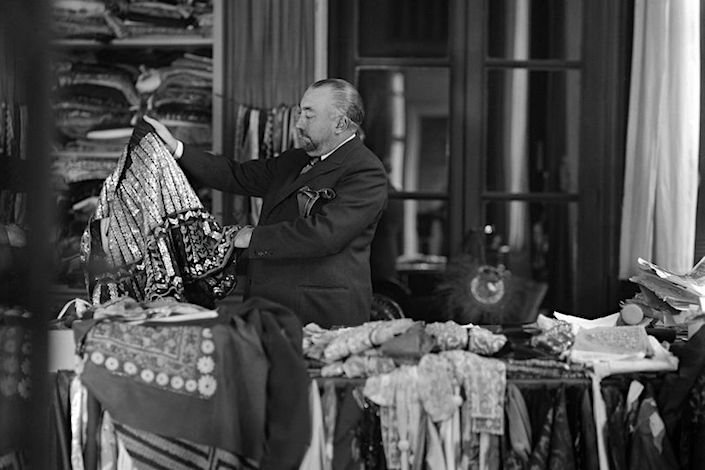Happy Birthday to Paul Poiret: A Trailblazing Fashion and Textile Designer
Exploring the Life and Impact of the "King of Fashion" on the World of Textile Design.
Happy birthday to the one and only Paul Poiret, the couturier, artist, iconoclast, and host extraordinaire who surely deserves his place as the greatest figure in the pre-World War I fashion world. Poiret's impressive vision of lush fabrics, rich colors, and bold prints created maximalist and joyful looks that continue to inspire designers and fashion lovers today. Despite his enormous success, he was unable to hold onto his fame and fortune and died in poverty.
Born on April 20th, 1879 in Les Halles, Paris, Poiret began his career as an umbrella maker's apprentice before working his way up the ranks at various fashion houses. In 1903, he launched his own shop and quickly gained notoriety for his daring and unconventional designs.
Poiret was a true iconoclast, unafraid to break with convention and champion then-risque uncorsetted looks. He introduced the chemise silhouette, harem pants, culottes, and kimono-like draped coats, all of which were radical departures from the structured and corseted styles of the day. He also loved free, naive pattern, and many beautiful prints in the archives of the great museums of the world are attributed to the man himself.
Poiret was a master marketer, arbiter of taste, and patron of the arts who enjoyed huge acclaim in the years before World War I. He was the first designer to present his clothing in flamboyant window displays at his namesake storefront, and he realized the importance of celebrity, outfitting many of Paris’ top stage actresses in his designs. His mansion was designed by Louis Sue, and his lavish theme parties where guests were dressed in his designs were legendary.
Other firsts included collaborating with leading artists and photographers, and taking his collections on tour, initiating the first trunk shows. Poiret commissioned Erté, George Barbier, Raoul Dufy and Dagobert Peche to illustrate his designs, and hired Edward Steichen to shoot pictures of his finished gowns. The artful images were published in the April 1911 issue of Art et Décoration, cementing one of the world’s first modern editorial fashion photo shoots.
“I am an artist, not a dressmaker.”
-Paul Poiret
His business met with enormous success, and in 1911, Poiret launched two new brand divisions, named for each of his daughters. Les Perfums de Rosine developed perfume and cosmetics, while La Maison Martine focused on home, interior, and textile design. The latter also included an art school for working-class girls called École Martine. There, young women sketched animals and botanicals that were turned into innovative textiles, wallpapers and rugs. He believed that the Viennese schools were too rigid and wanted freer, more natural approaches. Field trips to the botanical garden were apparently part of the curriculum for the school, which was housed in the upper floor of his atelier. Artists and industry members would attend design critiques and help refine and select designs for production.
He designed entire rooms with striking prints and bold colors inspired by the Arts and Crafts movement and worked with esteemed local makers to realize his vision. For wallpapers, he turned to the French company Defossé & Karth and designer Paul Dumas. Adolphe Chanaux made his furniture, and in nearby Venice, Murano created his hand-painted glassware. His deep pile carpets were hand-knotted by École Martine students.
In 1930, Poiret became F. Schumacher & Co’s very first collaborator, creating a capsule collection that featured nine vibrant prints of feathers and ribbons, pineapples and banana leaves, florals and botanicals, and even antelope galloping through a majestic landscape.
Dubbed the “King of Fashion” at the height of his popularity, he was undoubtedly the greatest figure in the pre-World War I fashion world and created the mold for the celebrity designer as we see it today.
Unfortunately, Poiret's over-the-top approach did not serve him well in the years following World War I, and he ended up selling his business (including the rights to his name) in 1929. The world was changing, and his great ability to predict trends and connect with his clientele were lost. Competition from the likes of Chanel ensured his downfall, and he died penniless; Elsa Schiaparelli paid for his burial.
However, his joyful and free designs proved to be influential well beyond his lifespan, and his appeal has proved timeless. An auction of his ex-wife's collection in 2005 brought great attention to his legacy, as did the Met's 2007 show of his work. Ninety years after the demise of the firm, the fashion brand returned to the Paris runways in March 2018, and Schumacher has turned to its rich archives to debut a new collection of Poiret's exuberant patterns.
It's inspiring to see these lush patterns and bold colors making a comeback in the world of fashion and design, and Poiret's legacy continues to inspire new generations of designers and fashion enthusiasts alike.
Happy Birthday, Paul Poiret!












































